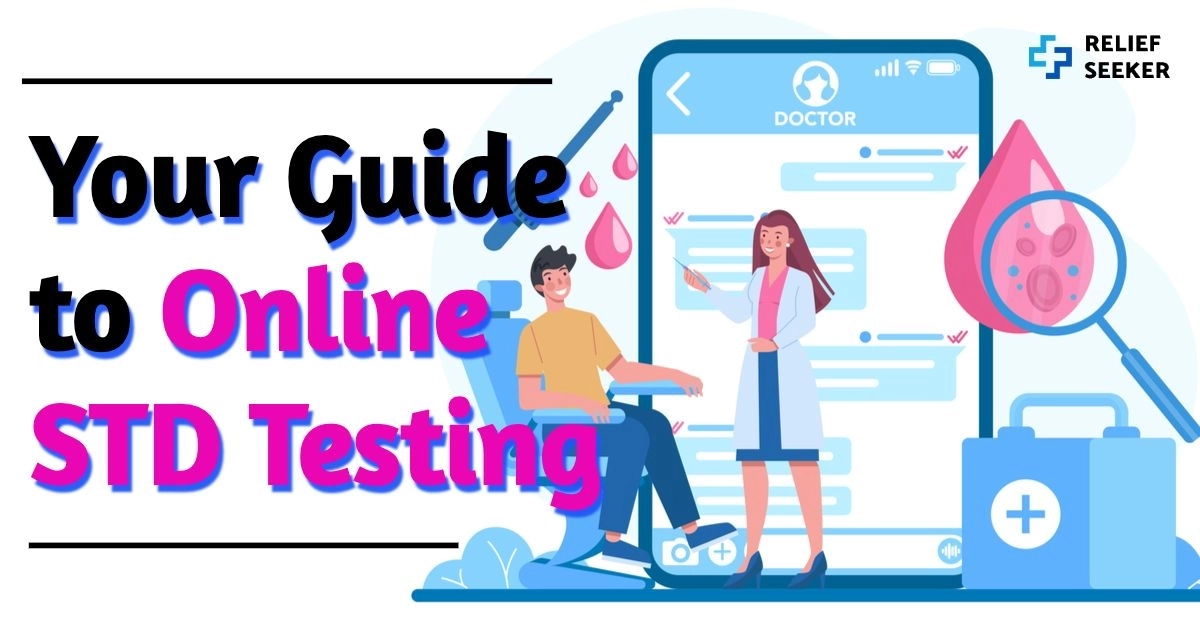Sexual health should be an important part of every patient’s health plan. When it comes to sexually transmitted diseases (STDs) and sexually transmitted infections (STIs), early detection can mean the difference between a speedy recovery and a lifetime of symptoms and risk factors.
Unfortunately, most people put off regular testing for STDs because of stigmas surrounding these diseases as well as income barriers to healthcare.
The good news is that telehealth testing services have made it extremely easy (and more affordable) to get tested for STDs.
Find out how to get online STD testing, avoid unprotected sex, and what to do if you think you’ve gotten an STD.
What Are STDs?
STD stands for sexually transmitted diseases. These diseases are transmitted through sexual intercourse, specifically through oral, vaginal, or anal intercourse.
This type of disease can cause symptoms in the area of infection, but STDs can also affect the immune, brain, heart, lymphatic, and nervous systems. If left untreated (or even after treatment) some STDs can lead to serious health conditions — and even death.
According to the Centers for Disease Control and Prevention (CDC), one in five people have STDs (either symptomatically or asymptomatically).
Though STDs carry serious stigmas in our society, they are treatable, and most STDs and STIs are even curable. The symptoms of those that aren’t are completely manageable.
Common STD Symptoms
STD symptoms vary from person to person, though there are common symptoms that indicate an infection.
The most common symptoms of STDs include:
Abdominal pain
Genital bumps
Genital burning or itching
Genital sores
Pain during sex
Pelvic pain
Penis or vaginal discharge
Unusual urine color
Vaginal or penile bleeding
While these are the most common symptoms of STDs, they are also symptoms of other common conditions, too. The only way to check for STDs is to get diagnosed by a doctor and take an STD test.
Some of the less common but more serious symptoms of some STDs include:
Aches and pains
Chills
Fatigue
Fever
Night sweats
Rash
Sore throat
Swollen lymph nodes
STDs VS STIs
STDs and STIs are two conditions that are commonly confused for each other. STIs are sexually transmitted infections (not diseases).
Most STDs start out as STIs (and not the other way around). When you start experiencing symptoms, you generally have an STD (often this is what happens if an infection is not treated or goes unnoticed).
Online STD Testing: When to Get Tested for STDs
There are two basic times that you should get tested for STIs and STDs: routinely and when symptoms arise.
Routine STD tests are generally performed once a year or every other year (depending on your doctor’s recommendation). Obviously, you want to catch an STI before it turns into an STD (but this is hard to do since STIs generally don’t produce symptoms).
Routine STD Tests
Depending on your sex life, you may want to get tested for STIs and STDs annually. Some doctors will recommend getting a full panel of tests annually — while others may recommend only getting tested for certain infections and diseases each year and others on a bi-annual basis.
Some of the most common regular STD tests (based on your sexual history and sexual activity) may include testing for:
HIV
Hepatitis B/hepatitis A
If left untreated, some STDs (like HPV) may turn into serious conditions and lead to life-threatening illnesses, such as cancer, so many doctors want to perform STD screenings for these issues on a regular basis.
Symptomatic STD Tests
If you are experiencing symptoms of an STD, you should get checked out right away. While STD screenings check for asymptomatic cases of STIs, STD tests are imperative for anyone experiencing symptoms, as there’s a probability your infection has exacerbated to a disease.
The good news is that just because you’re experiencing a symptom of an STD (such as genital discomfort, pain, or itching), doesn’t mean you actually have a sexually transmitted disease. The symptoms of STDs are also symptoms of other conditions (such as calcium deposits, yeast infections, and other issues), so you don’t need to worry — but you still need to get checked out right away.
Many STDs (such as syphilis and HIV) can be life-threatening and/or lead to other more serious conditions. Getting a syphilis test or an HIV test and treatment sooner rather than later will help prevent more serious symptoms down the line.
How At-Home STD Tests Work
At-home STD test kits are easy to use and relatively straightforward. Unlike lab tests (which often require a blood sample, a trip to a doctor’s office, and a trip to a lab), at-home tests usually only require a urine sample, a finger prick, or a saliva swab.
How It Works
Simply order an at-home STD test from a company like EverlyWell. Fill out a few forms online, and get your kit in a few days. Follow the instructions, and mail your sample back to the lab. Your test results should be available within a few business days (and you can check your results online).
At-Home STD Testing Accuracy/Safety
Online STD testing is just as accurate as lab testing. Many doctors now recommend ordering at-home tests (especially if you don’t want to be exposed to sick patients in a lab waiting room during a pandemic).
At-home tests are also extremely safe. Telehealth health tests are approved by the FDA, and companies must abide by HIPAA patient safety guidelines.
Websites use SSL certificates and encryption, and data is stored on secure servers. You may also request that your information be removed from the server and destroyed at any time, should you feel worried about the security of your information.
If you’re concerned about the social stigmas surrounding STDs, at-home testing can feel more safe and secure, as you won’t need to leave your home to get tested or get results.
Common STDs Treated by Online Doctors
The most common STDs treated by online doctors include:
Chlamydia/Gonorrhea
Hepatitis C
HIV
Female STD Panel
Male STD Panel
Syphilis
Trichomoniasis
How to Get Treated for STDs Online
There are several ways to get treated for STDs online. You can either order an STD test for yourself through an at-home testing company if you know what type of infection or disease you may have contracted.
Or, contact an online doctor like Health Sapiens if you don’t know which test to order. You’ll simply fill out a form, make an appointment for a telehealth consultation, and chat with a doctor.
Get Tested for STDs
Before getting treated for STDs, you’ll need to get tested for them first. You can do this either by heading to a lab for a blood test or urine test — or by simply ordering an at-home test, as long as an STD test is available for your condition (though most STD lab testing is available for at-home use, even HIV tests).
If you get back a negative result, no worries! You will need to get tested for other possible conditions related to your symptoms, but you won’t need to worry about STDs necessarily.
Should your test return a positive result, you’ll want to contact your doctor right away for treatment. You’ll want to know how far along the disease has progressed, if there are underlying issues, and your treatment options — all of which an online doctor can help you with.
Make an Appointment With an Online Doctor
If you haven’t already had a consultation with a doctor before getting tested, you’ll want to do so now (whether or not your test results come back negative). Online general practitioners and online urgent care clinics commonly treat STDs.
You’ll want to make an appointment with a doctor online with a company like Health Sapiens. Different online doctor platforms have different fee structures. Some offer one-off appointments and follow-ups while others charge a monthly fee for services.
Simply head to the platform’s website, fill out a few forms, explain your symptoms, and submit your test results.
Get a Consultation
Most online doctors offer same-day or same-week appointments. You should be able to chat with a doctor (in most cases) within a few hours of submitting your intake paperwork.
Download the platform’s software or app, or make an appointment for a phone consultation. When it’s time for your appointment, simply call or log on to the platform. Chat with your doctor about your symptoms, get a diagnosis (if possible over a telehealth visit), and get a treatment plan.
Online doctors can offer lifestyle advice and write prescriptions (if necessary). You can fill your prescription at your local pharmacy or at an online pharmacy. If you don’t have health insurance, you can ask your doctor to write a prescription for a generic medication instead of a brand-name one.
Start Treatment
Once you get your treatment plan, you’ll want to follow your doctor’s advice. Take all medication as directed, and make all appropriate lifestyle changes.
Most online platforms include at least one complementary follow-up appointment with your doctor in the price of your consultation and treatment (but you should always check with the platform first just to be on the safe side).
If your STD has resulted in further complications, you may need to head to your general practitioner’s office for further treatment and follow-ups. When it comes to your sexual health, you can never be too careful, as untreated STDs can lead to complications, such as infertility, sterility, and other conditions.
Online STD Testing and Treatment
Your doctor will recommend treatment of your STD based on the severity of your condition, other underlying conditions, and your medical history. Common STD treatments include prescription medication and lifestyle changes to manage symptoms (and prevent the further spread of an STD).
Online STD Prescriptions
Depending on what type of STD you suffer from your doctor may prescribe prescription medication to manage symptoms, prevent the spread of infection, and prevent further complications.
Cefixime, ceftriaxone, ciprofloxacin, and ofloxacin are four medications used to treat chlamydia, gonorrhea, and syphilis.
The medications acyclovir, famciclovir, and valacyclovir are commonly used to treat genital herpes.
If you have HIV, there are treatment options available (though the treatment regimen is more complicated than treatments for some other STDs). Most doctors prescribe prEP HIV and non-nucleoside reverse transcriptase inhibitors (NNRTIs), such as lamivudine, tenofovir disoproxil fumarate, and zidovudine. You may need to see a doctor in person for these treatments.
Lifestyle Changes
Your doctor will probably also recommend a few lifestyle changes (depending on the STD you’ve contracted). These changes may be related to sexual health (getting regular check-ups to catch STIs before they turn into STDs, using preventative measures to prevent STDs, and other preventative measures). Birth control, such as an IUD, or hormonal birth control pills or shots, do not prevent STDs.
It’s also important to note that STDs are often transmitted through sexual assault. If you’re the survivor of an assault, it’s important to remember that infection or disease is not your fault. You should seek medical treatment immediately, ask for a rape kit, and get tested regularly for STDs. There are also mental healthcare services available to you.
Paying for STD Tests/Treatment
The good news is that at-home STD tests are relatively inexpensive and don’t require you to take time off of work to commute to a doctor’s office or lab for testing.
Most STD tests range in cost from $49 a test to $149 per test. Your results are included in the price of the test kit.
Most online doctors charge between $15 and $50 to diagnose an STD and provide a treatment plan. Platforms such as Health Sapiens charge a $30 monthly fee to keep a doctor on retainer for virtual visits, follow-up questions, and further treatment plans.
Some online doctors accept health insurance, while others do not. You should always check with both the telehealth healthcare provider and your insurance company before scheduling an appointment to ensure your treatment is covered.
Most telehealth platforms accept payment through FSA and HSA plans.
If you don’t have health insurance, you can rest assured knowing that most telehealth platforms charge reasonable fees for services. You can expect to pay anywhere between $65 and $200 for testing and treatment for an STD (whereas most in-person doctors and testing labs will often charge double that amount).
Online STD testing makes it so much easier to check for STDs, manage symptoms, and prevent further infections.


